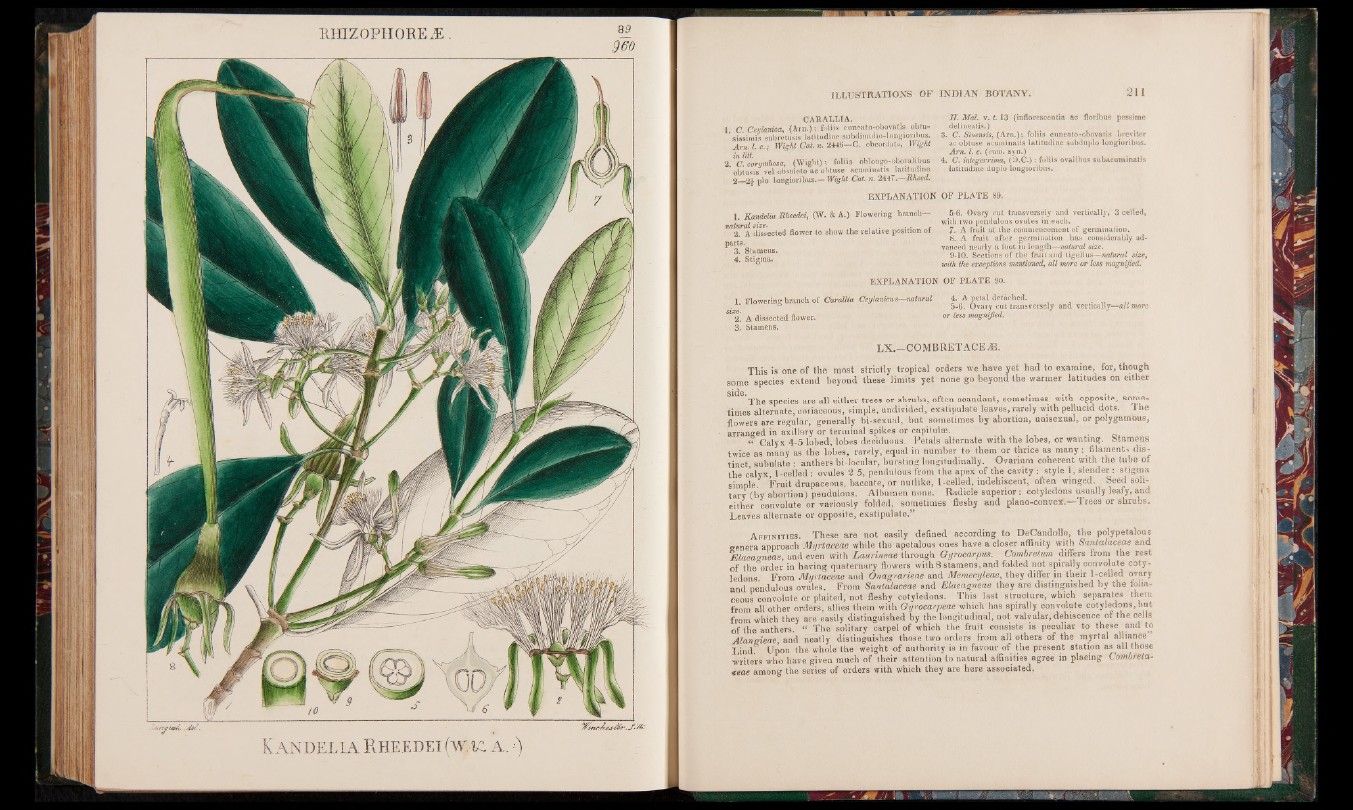
RHIZ OPH OKE Æ .
Rit n-o cadi,. dec.
Ka n d e l ia RHEEDEI (W.Vl A. •)
CARALLIA.
1; C. Ceylanica, (ftvn.); foliis cuneato-obovatis obtu-
sissirais subretusis latitudine subdimidio-longioribus.
A r n .l .c .; Wight Cat. n. 2446—C. obcordata, Wight
inlilt. BHH .,_ .
2. C. corymbosa, (Wight); Coins oblongo-oboyalibus
obtusis vel obsoleto ac obtuse acuminatis latitudine
2__2% plo longionbus.— Wight Cat. n. 2447. Rheed.
EXPLANATION
1. Kandelia Bheedei, (W. & A.) Flowering branch—
natural size. ... .
2. A dissected flower to show the relative position ot
parts.
. 3. Stamens.
4. Stigma.
EXPLANATION
1. Flowering branch of Carallia Ceylanicus—natural
size.
2. A dissected flower.
3. Stamens.
H . Mdi. v. t. 13 (inflorescentia ac floribus pessime
delineatis.)
3. C. Sinensis, (Am.); foliis cuneato-obovatis breviter
ac obtuse acuminatis latitudine subduplo longioribus.
A m . I. c. (cum. syn.)
4. C. integenima, (D.C.) ; foliis ovalibus subacuminatis
latitudine duplo longioribus.
OF PLATE 89.
5-6. Ovary cut transversely and vertically, 3 celled,
with two pendulous ovules in eacb.
7. A fruit at the commencement o f germination.
8. A fruit after germination has considerably advanced
nearly a foot in length—natural size.
9-10. Sections of the fruit and tigellus—natural size,
with the exceptions mentioned, all more or less magnified.
OF PLATE 90.
4. A petal detached.
5-6. Ovary cut transversely and vertically—all more
or less magnified.
LX.—COMBRETACEÆ.
This is one of the most strictly tropical orders we have yet had to examine, for, though
some species extend beyond these limits yet none go beyond the warmer latitudes on either
S' 6 The species are all either trees or shrubs, often seandent, sometimes with opposite, sometimes
alternate, coriaceous, simple, undivided, exstipulate leaves, rarely with pellucid dots. The
flowers are regular, generally bi sexual, but sometimes by abortion, unisexual, or polygamous,
arranged in axillary or terminal spikes or capitate.
« Calyx 4-5 lobed, lobes deciduous. Petals alternate with the lobes, or wanting. Stamens
twice as many as the lobes, rarely, equal in number to them or thrice.as many: filaments distinct
subulate : anthers bi locular, bursting longitudinally. Ovarium coherent with the tube of
the calyx 1-celled : ovules 2 5, pendulous from the apex of the cavity : style 1, slender : stigma
simple Fruit drupaceous, baccate, or nutlike, 1-celled, indehiscent, often winged. Seed solitary
(by abortion) pendulous. Albumen none. Radicle superior: cotyledons usually leafy, and
either convolute or variously folded, sometimes fleshy and plano-convex. Trees or shrubs.
Leaves alternate or opposite, exstipulate.”
Affinities. These are not easily defined according to DeCandolle, the polypetalous
genera approach Myrtaceae while the apetalous ones have a closer affinity with Santalaceae and
E laeagneae, and even with L a u rin ea e through Gyrocarpus. Combretum differs from the rest
of the order in having quaternary flowers with 8 stamens, and folded not spirally convolute cotyledons.
From Myrtaceae and Onagrarieae and Memecyleae, they differ in their 1-celled ovary
and pendulous ovules. From Santalaceae and Elaeagneae they are distinguished by the folia-
ceous convolute or plaited, not fleshy cotyledons. This last structure, which separates them
from all other orders, allies them with Gyrocarpeae which has spirally convolute cotyledons, but
from which they are easily distinguished by the longitudinal, not valvular, dehiscence of the cells
of the anthers. 1 The solitary carpel of which the fruit consists is peculiar to these and to
A la n g iea e and neatly distinguishes those two orders from all others of the myrtal alliance ’
liind. Upon the whole the weight of authority is in favour of the present station as all those
■writers who have given much of their attention to natural affinities agree in placing Combreta-
tea e among the series of orders with which they are here associated.